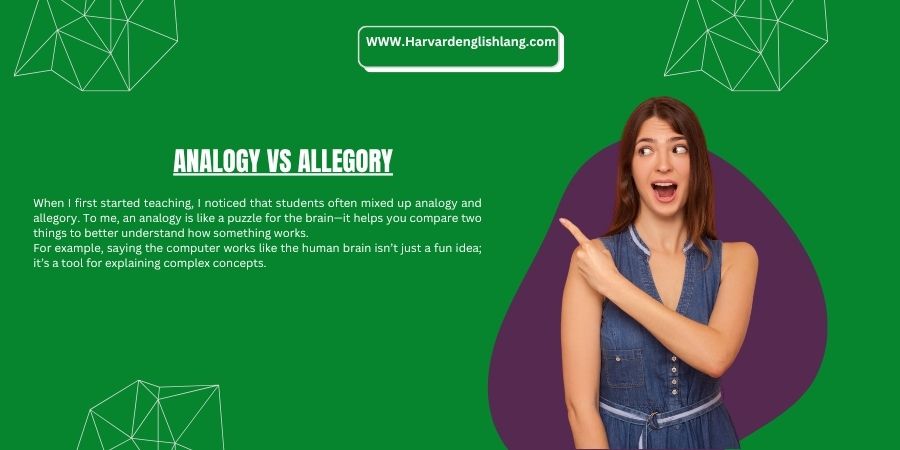When I first explored the world of literary devices, I found myself tangled in the confusion between analogy and allegory.
Both are powerful tools in storytelling skills, yet they carry distinct meanings and serve different purposes.
An allegory often contains a hidden meaning, sometimes moral or political meaning, like the famous story of George Washington and the cherry tree that aims to teach children the importance of honesty.
This picture is more than just a simple story; it’s a guide to deeper understanding through symbolic representation.
On the other hand, an analogy uses a comparison of different things to explain or demonstrate a point clearly, like when you imagine a blanket of fog covering everything with a soft white hue.
This helps improve communication by making abstract or complex ideas easier to grasp. Understanding their origins and practical applications sharpens one’s ability to use these devices effectively.
Both tools enrich language and thought, expanding how we share meanings and concepts in our daily lives.
Analogy
From my experience, an analogy is a useful tool designed to help understand complex concepts by comparing two things and highlighting their similarities.
For example, someone might say that life is a journey with different stages, challenges, and obstacles to be encountered. This kind of comparison makes life’s experiences more familiar and easier to relate to.
Unlike metaphors or similes, which focus more on artistic expression, analogies aim to clarify and enhance understanding by explaining ideas clearly.
Using an analogy helps me explain things better by connecting new or hard ideas to something people already know.
It’s like breaking down a concept into simpler parts, making it easier to grasp. Whether through metaphors, similes, or direct comparison, an analogy acts as a bridge between what we know and what we want to learn, allowing deeper insight into complex topics.
Allegory
From my experience, an allegory is more than just a simple story; it uses figurative symbolism to convey deeper meaning and moral principles through its characters, events, and narrative.
Take the classic Tortoise and the Hare—this political allegory teaches perseverance and warns against overconfidence through the traits of its animals.
Similarly, George Orwell‘s Animal Farm uses animals to represent the rise of communism and the corruption of power, blending political concepts with a powerful medium that helps us grasp complex ideas in an engaging way.
An allegory often involves layered meanings, mixing a surface narrative with abstract ideas and symbolism that demands a deeper look to fully understand the message.
Plato’s Allegory of the Cave is a metaphorical tale exploring the nature of reality and enlightenment, inviting readers to reflect on their own perceptions.
These stories function as a storytelling technique that offers both a familiar and thought-provoking way to present moral lessons and political allegory alike, making the concept accessible yet profound.
You Might Also like: Align To or Align With: Smart Tips You Need!
How To Use Analogy and Allegory In Sentences

Analogy:
An analogy helps by using a relatable example to explain a coYou Might Also like:ncept or idea. It works by comparing two different things and showing how one shares similarities with the other.
For instance, you might say, “Understanding how a computer works is like understanding how a car engine functions.”
This kind of sentence makes complex ideas easier to grasp by identifying familiar parts in unfamiliar topics. Using the right words and clear comparison can improve how we communicate and learn new things in different situations.
I’ve often found that breaking down difficult subjects through analogy helps me better understand and remember them. It’s a simple but effective way to bridge gaps in knowledge by connecting what we know to what we want to learn, using everyday examples that function similarly to the idea being discussed.
Allegory:
When talking about allegory, I often recall the fable of the tortoise and the hare. On the surface, it’s just a story about a race between a slow, steady competitor and a fast, sometimes arrogant one.
But when you interpret it, you uncover a deeper meaning—a moral about the importance of perseverance and humility. This narrative is more than just entertaining events; it’s built from characters, settings, and elements that symbolize abstract concepts and real-world situations.
An allegory works by using each scenario to convey a message that invites readers to think beyond what’s directly written in the sentence.
The symbolic layers encourage you to identify the lesson within and see how concepts can apply to your own life.
n my own reading experiences, these kinds of examples make me pause and reflect, helping me recognize values in a way plain explanation never could—they’re like a mirror that reflects both imagination and truth at the same time.
Common Mistakes to Avoid when using Analogy and Allegory
Analogy:
- Overcomplicating – Avoid making the analogy too complex, or it may confuse rather than clarify.
- Inaccurate Comparison – Ensure the two things compared share relevant similarities.
- Mixing Concepts – Don’t combine unrelated ideas in the same analogy.
- Cultural Bias – Be mindful of references that may not be understood by all audiences.
- Literal Interpretation – Remind readers that an analogy is figurative, not literal.
Allegory:
- Too Obvious – If the allegory is too direct, it loses its depth and symbolic value.
- Overcrowded Symbols – Using too many symbols can overwhelm the reader.
- Inconsistent Symbolism – Keep the meaning of symbols consistent throughout the story.
- Weak Narrative – A strong allegory still needs an engaging story and characters.
- Ignoring Context – Make sure the allegory resonates with the audience’s cultural or real-world experiences.
You Might Also like: Moment vs. Momment: Ultimate Guide to Clarity!
Examples of Analogy and Allegory Used in Literature and Communication
Examples of Analogy:
- Life is like a journey – It has different stages, challenges, and destinations.
- A computer works like a brain – It processes information and stores memories.
- Learning a language is like building a house – You need a strong foundation before adding details.
- Time is like a river – It flows in one direction and never stops.
- Friendship is like a garden – It needs care and attention to grow.
- Writing is like painting – You create images, but with words instead of colors.
- Memory is like a filing cabinet – You store information and retrieve it when needed.
- Education is like climbing a mountain – It takes effort, but the view from the top is worth it.
Examples of Allegory:
- The Tortoise and the Hare – A fable that symbolizes perseverance and humility over arrogance.
- Animal Farm by George Orwell – A story that represents political power and corruption.
- The Lion, the Witch and the Wardrobe – An allegory for faith, sacrifice, and redemption.
- Pilgrim’s Progress by John Bunyan – A journey that symbolizes a Christian’s path to salvation.
- Lord of the Flies by William Golding – A story reflecting human nature and the loss of civilization.
- Plato’s Allegory of the Cave – A metaphor for enlightenment and understanding reality.
- Moby-Dick by Herman Melville – An allegory of obsession and the human struggle against nature.
- The Giving Tree by Shel Silverstein – A tale symbolizing unconditional love and selflessness.
Analogy vs Allegory

When I first started teaching, I noticed that students often mixed up analogy and allegory. To me, an analogy is like a puzzle for the brain—it helps you compare two things to better understand how something works.
For example, saying the computer works like the human brain isn’t just a fun idea; it’s a tool for explaining complex concepts.
I’ve found that planning ahead and using clear analogies can make the importance of learning obvious, just like solving a riddle where you have to find the missing piece.
An allegory, however, is a story with a hidden message, where characters, events, and stories represent deeper meanings.
Think of the classic tale of the ant and the grasshopper—the ant’s hard work and the grasshopper’s laziness aren’t just about insects; they’re about being responsible and the importance of planning ahead.
When I use an allegory in class, I notice students pick up on similarities between the surface plot and real-life situations, allowing them to compare and find lessons they might otherwise miss. It’s like gently solving a life puzzle without them realizing they’re learning.
| Aspect | Analogy | Allegory |
| Definition | A comparison between two things to explain an idea or concept. | A story with hidden meanings where characters, events, and symbols convey a message. |
| Purpose | Helps in understanding by comparing similarities. | Communicates a moral, political, or philosophical message through symbolism. |
| Structure | Short, direct, and often one or two sentences. | Extended story or events with multiple layers of meaning. |
| Example | “The brain works like a computer.” | “The ant represents hard work and the grasshopper represents laziness.” |
| Scope | Focused on a single comparison. | Covers the entire story with symbolic characters and ideas. |
| Use in Writing | Found in analogies and comparisons to explain concepts clearly. | Found in stories and allegories to deliver hidden messages. |
| Length | Typically brief. | Can span an entire narrative. |
Origins of Analogy
When I first studied ancient Greek philosophy, I learned that the term analogy comes from the roots ana (“up” or “upon”) and logos (“word,” “reason”).
In those early days, scholars used it as a tool to explain complex ideas by showing the similarities and correspondence between things.
It was less about direct comparison and more about a balance or proportion—a way of likening concepts so they became familiar and simpler to grasp.
Over time, this practice evolved into a refined linguistic and cognitive method for clarifying meaning. I’ve often used analogies in my own teaching—turning abstract theories into everyday examples—to guide others up from confusion toward clarity.
It’s a subtle art: starting with familiar things and leading people upon new insights, making even the densest material feel approachable.
Origins of Allegory
When exploring allegory, I’ve often gone back to its roots in ancient times, where it originates in Greek as allegoria, formed from allos (“other”) and agoreuein (“to speak openly” or tell).
In Latin, it retained a similar meaning and was used to convey ideas through figurative representation and symbols. It originally referred to a form of communication where a deeper, sometimes hidden, layer of thought was conveyed over time, often in literary or fictional narratives.
In my own reading of moral, political, and philosophical works, I’ve seen how this technique evolved, retaining its power to shape thought.
It became a way to embed complex truths in stories that feel different on the surface but reveal much more underneath. From classic fables to modern allegories, the word still carries that timeless ability to connect, hint, and inspire in ways plain language cannot.
FAQs Related allegory vs analogy
Are parables considered allegories or analogies?
Parables are mostly seen as allegories. They are short stories that use characters and events to teach deeper moral or spiritual lessons.
Unlike analogies, which usually make a direct comparison between two things, parables use a whole narrative to symbolize bigger ideas. So, while both help explain concepts, parables fit better as allegories because of their storytelling nature and symbolic meaning.
How do allegory vs metaphor vs analogy differ?
Though allegory, metaphor, and analogy all involve comparisons, they work a bit differently. An allegory is an extended story or narrative where nearly everything has a hidden meaning, often teaching a moral or political lesson.
A metaphor is a direct comparison between two unrelated things, saying one thing is another to highlight a quality (like “time is a thief”). An analogy explains an idea by comparing it to something more familiar, usually to make complex concepts easier to understand. So, allegories are big stories, metaphors are quick comparisons, and analogies are explanations through comparison.
Is a proverb an analogy?
Not exactly. A proverb is a short, well-known saying that expresses a general truth or advice, like “A stitch in time saves nine.”
While some proverbs use analogy by comparing situations, not all are analogies. Proverbs are more about conveying wisdom or common sense, sometimes using analogy, but they stand on their own as wise sayings rather than detailed comparisons.
A Final Look at Analogy vs Allegory
In my experience, analogies and allegories are like two literary devices that share comparisons yet serve very different roles. An analogy works with direct links, helping readers gain comprehension by linking familiar concepts to complex ideas.
It facilitates understanding through clarity, while an allegory moves through storytelling and narrative to express symbolic representation.
Both can be powerful when conveying moral or philosophical messages, especially when you want to clarify an abstract thought.
I’ve found that allegories often weave layered meanings, embedding hidden truths that invite interpretation. They can carry nuanced lessons over time, drawing people into a deeper space of reflection.
Appreciation for these forms grows when you notice how they enrich communication, express cultural importance, and carry timeless wisdom through literature. Whether you prefer the straightforward path of analogies or the richly layered journey of allegories, both remain essential tools for enriching thought and appreciation of literature.

A communication coach with a background in public speaking and business English. He helps professionals refine their English for workplace success.
